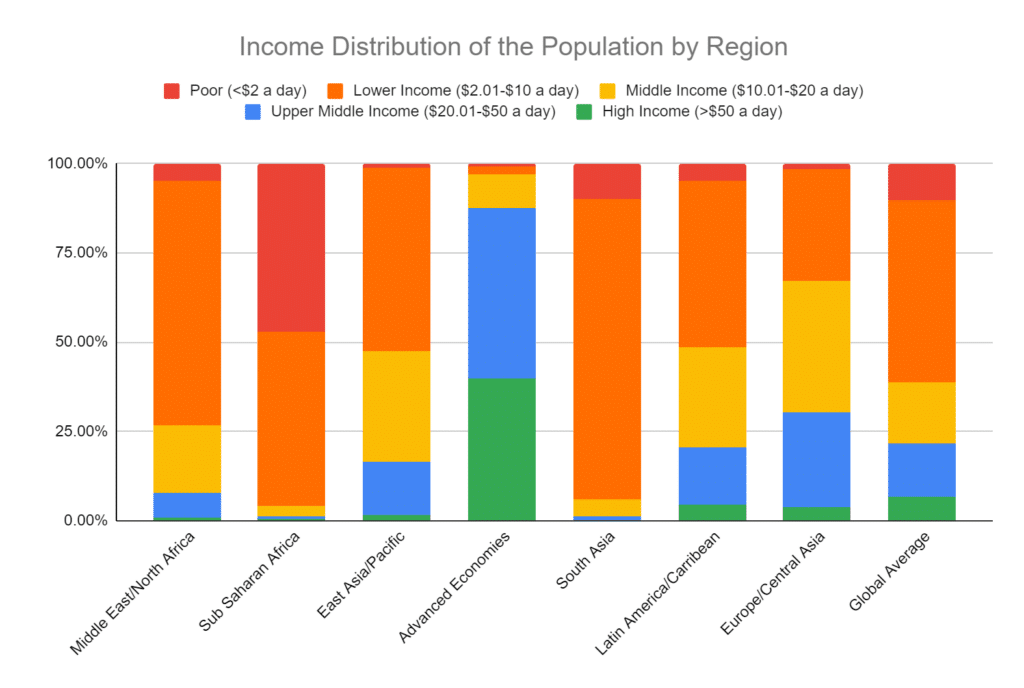There is no doubt that we live in an age of abundance. Superabundance even.
If you have any doubt, please read Marian Tupy and Gale Pooley’s masterpiece, Superabundance: The Story of Population Growth, Innovation, and Human Flourishing on an Infinitely Bountiful Planet. Tupy and Pooley provide strong evidence of how much progress the world has made over the past few hundred years, spurred largely by innovation. From eggs and iced tea to books and televisions, the authors describe–quite convincingly–how the time-price of many products and services has plummeted. In other words, it takes the average person in the world much less time today to work to purchase a dozen eggs or a flat screen television than it did 30 years ago.
Even Africa, the poorest continent today, has recorded progress over the past several decades. In education, the percentage of children attending primary school is close to 100%, up from approximately 74% in 1998. For secondary school, the percentage has almost doubled from 23% in 1993 to 44% in 2020. In healthcare, similarly impressive statistics abound. Maternal mortality, for instance, has shrunk from 870 deaths per 100,000 births to around 530. Infant mortality has been halved from 107 deaths per 1,000 births to 50. Clearly, life in Africa and, by extension the world, today is better than it was decades ago.
The progress of the past, however, does not negate the struggle of the present. Even in a world of superabundance, too many people still struggle.
For example, today, in our world of superabundance, fewer than 7% of the global population lives on more than $50 a day, or $18,250 annually. Those who fall in this bracket are called high-income earners, the vast majority of whom live in advanced economies.

Source: Pew Research Center, https://www.pewresearch.org/short-reads/2021/07/21/are-you-in-the-global-middle-class-find-out-with-our-income-calculator/
In Africa, a continent home to more than 1.3 billion people, fewer than 4 million people (0.3%) live on more than $50 a day. One percent, or 13 million live on more than $20 a day, or $7,300 a year. In South Asia, the Middle East and North Africa, and Latin America and the Caribbean, 0.1%, 0.8%, and 4.3% live on more than $50 a day respectively.
Simply put, this means most people in the world are struggling. Struggling to access housing; struggling to access quality healthcare when they are sick and most vulnerable; struggling to access credit to start or grow a business; struggling to live in a functioning democracy; struggling to travel for leisure or take a sick day off work; struggling to feel secure about their future and the future of their children; struggling to put food on the table without worry; struggling to emigrate to another country to find better opportunities; and perhaps saddest of all, struggling simply to survive, much less thrive.
Superabundance, it turns out, has not yet reached the masses. But it can.
At the Christensen Institute, we espouse the virtues of market-creating innovations. These innovations target nonconsumers—the segment of the population who would benefit by owning or using a product but cannot due to the product’s cost, time, or the expertise needed to use it. Market-creating innovations transform complex and expensive products into simple and more affordable products, making them accessible to a wider segment of the population–nonconsumers.
In Mexico for example, Clinicas del Azucar is making diabetes care more accessible to millions of Mexicans for whom care was too expensive or time consuming. Despite diabetes being the leading cause of death and amputations in the country and also a major cause of blindness, stroke, and depression, tens of millions of Mexicans simply lived with the disease.
Javier Lozano’s market-creating innovation targeted these people. Today, Clinicas del Azucar is a chain of diabetes clinics that has reduced the cost of diabetes care by more than 75% and the number of locations and visits it takes to get care by more than 80%. Clínicas del Azucar patients also get better care compared with traditional diabetes treatment centers.

Innovations like Clinicas del Azucar create jobs, increase wealth, generate taxes, and change the cultural dynamics of a region to one where innovation and entrepreneurialism are at the center of development. It is this innovation and entrepreneurship, anchored in human ingenuity, that Tupy and Pooley celebrate in their book, Superabundance.
We live in an age of superabundance. But too few people have actually experienced this phenomenon. Market creation can unlock it for the masses.
At the Christensen Institute, we have developed a Market-Creating Innovation Bootcamp for organizations and policymakers. Please email us at info@christenseninstitute.org to learn more.



